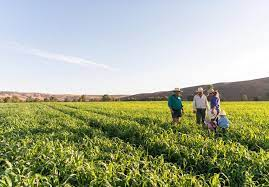Mixed news for crop production
Luke Williams
04 May 2023, 7:40 AM

Total summer crop production in NSW is forecast to fall 19% in 2022–23 to 2.4 million tonnes, but this is still 28% above the 10-year average for 2021–22, according to the Australian Bureau of Agricultural and Resource Economics and Sciences (ABARES) latest forecast.
ABARES forecast that the area planted for summer crops is to have fallen marginally to 728,000 hectares, and ABARES expects hot dry weather over the summer months to reduce yields relative to 2021–22.
The government body says winter crop production in New South Wales is estimated to be 15.1 million tonnes in 2022–23 - 35% above the 10-year average to 2021–22 but 20% below the near-record production of last year.
Charly Xia, ABARES Economist told the Western Plains App, "NSW had a pretty good cropping season despite flooding across spring. So overall, the total production was well above average results".
He said the most significant impact in terms of crop quality and floods was on wheat and canola.
"However, we are forecasting above-average production for the summer crop all of NSW. March conditions were particularly good."
The forecast is for cotton production to decline 16% in 2022–23 due to wet conditions through September and October. However, ABARES expects, dryland cotton plantings to expand significantly across many catchments in northern New South Wales.
It comes as a Cotton Australia report says that "in the Macquarie Valley, picking has just started north of Warren after farmers reported a 30% crop reduction due to the well-above rain recorded in 2022.
The upside is that quality is expected to be good, and above average temperatures in February and March have provided very good boll filling conditions for crops"

Image: Regional Investment Corporation.
"We expect conditions to be quite good for winter crop sowing," Xia further explained.
He said that in the three months to March 2023, above-average rainfall totals and below-average summer temperatures resulted in above-average to extremely high pasture production for this time of year across much of northern Australia.
Although extremely low to below average pasture growth rates were recorded across isolated parts of southern Western Australia, much of Victoria, and much of New South Wales owing to above average temperatures and below average rainfall.
This week between 15 and 25 millimetres of rain are expected to fall across Northern NSW cropping regions.




